The History of the Modern Graphics Processor - hickmanittly1948
The evolution of the modern graphics processor begins with the introduction of the first 3D add-in cards in 1995, followed by the widespread adoption of the 32-bit in operation systems and the cheap personal calculator.
The graphics industry that existed before that mostly consisted of a more matter-of-fact 2D, non-PC architecture, with graphics boards healthier glorious by their chip's alphanumeric appointment conventions and their huge price tags. 3D gaming and virtualization PC nontextual matter finally united from sources as diverse as arcade and console gaming, martial, robotics and blank space simulators, as well as Greco-Roman deity imaging.
The early days of 3D consumer artwork were a Wild West of competitive ideas. From how to implement the computer hardware, to the use of unusual rendering techniques and their application and data interfaces, as healed as the unforgettable naming hyperbole. The early graphics systems faced a regressive function grapevine (FFP), and an architecture following a real rigid processing route utilizing all but American Samoa many nontextual matter APIs as there were 3D chip makers.
While 3D graphics turned a evenhandedly dull Personal computer industry into a light and magic show, they owe their being to generations of innovative endeavour. This is the first gear installment on a serial publication of five articles that in chronological order, take an extensive view the history of the GPU. Going from the early days of 3D consumer graphics, to the 3Dfx Voodoo brave-changer, the industry's integration at the turn of the century, and today's modern GPGPU.
1976 - 1995: The Early Days of 3D Consumer Graphics
The first true 3D nontextual matter started with early display controllers, titled video shifters and video address generators. They acted equally a pass-through with betwixt the main processor and the display. The succeeding information stream was converted into consecutive bitmapped video output such as luminance, color, as well Eastern Samoa vertical and horizontal composite plant sync, which kept the line of pixels in a display generation and synchronised from each one successive line along with the blanking separation (the clock between ending one scan line and starting the next).
A flurry of designs arrived in the latter half of the 1970s, laying the foundation for 3D graphics as we know them. RCA's "Pixie" television chip (CDP1861) in 1976, for instance, was capable of outputting a NTSC compatible video signal at 62x128 resolution, or 64x32 for the ill-starred RCA Studio II console table.
The video chip was quickly followed a year later by the Television User interface Adapter (TIA) 1A, which was organic into the Atari 2600 for generating the screen display, strong effects, and reading input controllers. Development of the TIA was led by Jay Miner, who besides led the design of the custom chips for the Commodore Amiga computer afte.
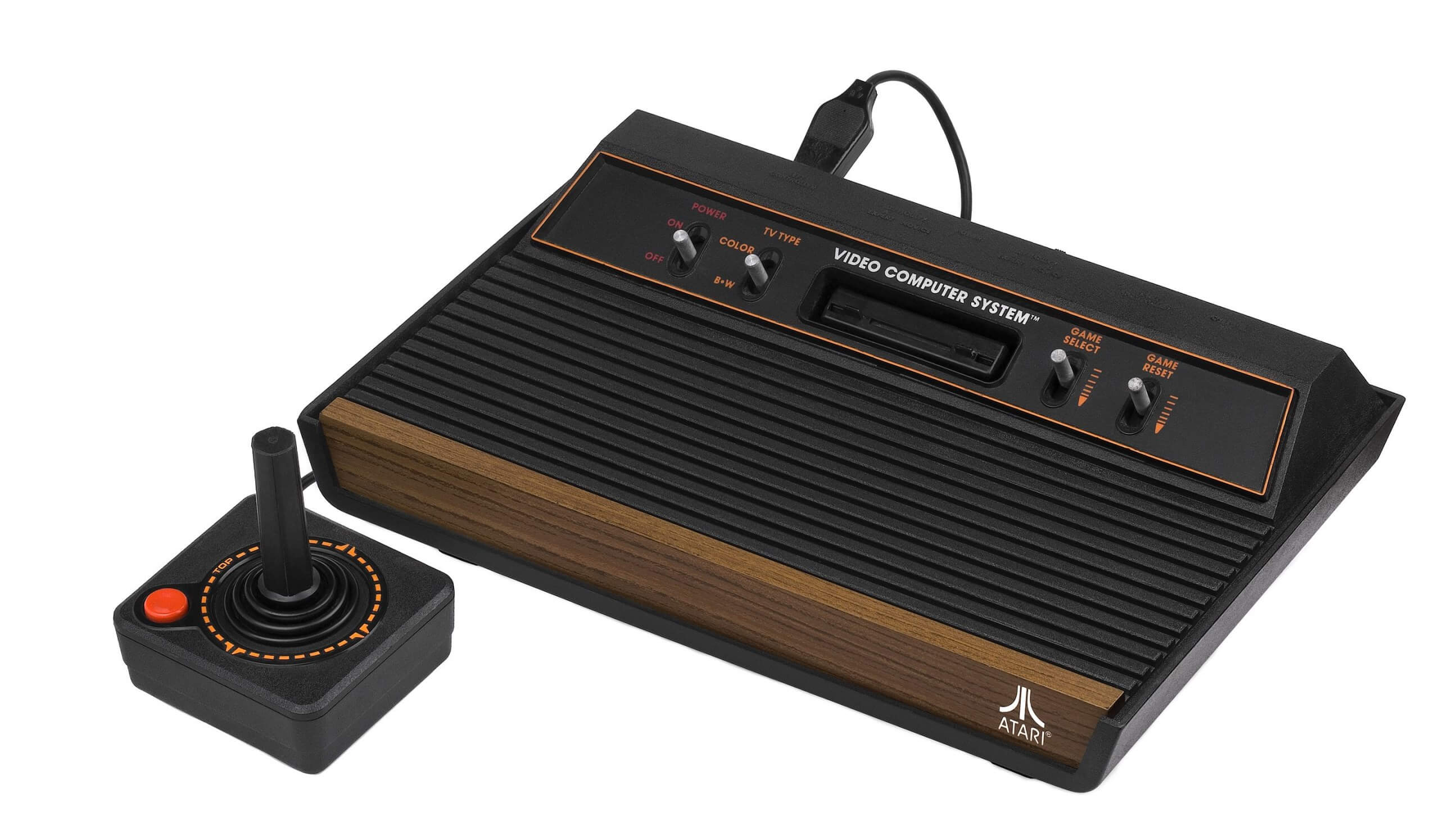
In 1978, Motorola unveiled the MC6845 video address author. This became the basis for the IBM Personal computer's Monochrome and Vividness Display Adapter (MDA/CDA) cards of 1981, and provided the same functionality for the Apple II. Motorola added the MC6847 display generator later the same twelvemonth, which made its way into a amoun of first generation personal computers, including the Jessica Tandy TRS-80.
A related solution from Commodore's MOS Technical school auxiliary, the VIC, provided graphics output for 1980-83 vintage Commodore home computers.
In November the following twelvemonth, LSI's ANTIC (Alphanumeric Goggle bo Interface Controller) and CTIA/GTIA co-processor (Color or Art Television Interface Adaptor), debuted in the Atari 400. ANTIC processed 2D display instructions exploitation conduct memory access (DMA). Ilk most telecasting cobalt-processors, it could generate playfield graphics (background, title screens, scoring display), while the CTIA generated colors and moveable objects. Yamaha and Lone-Star State Instruments supplied similar IC's to a salmagundi of primitive home computer vendors.
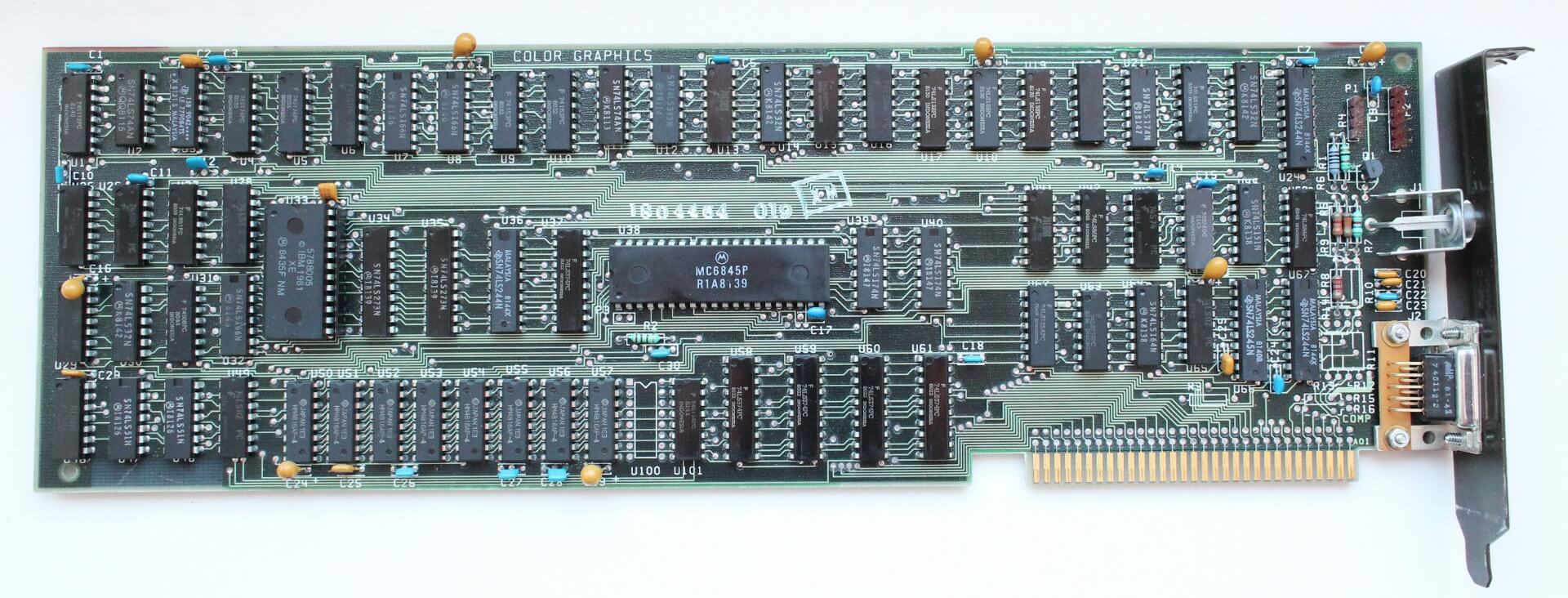
The next stairs in the graphics organic evolution were primarily in the professional William Claude Dukenfield.
Intel used their 82720 nontextual matter chip as the basis for the $1000 iSBX 275 Video Graphics Controller Multimode Board. Information technology was capable of displaying eight colour in information at a resolution of 256x256 (or monochrome at 512x512). Its 32KB of display memory was enough to draw lines, arcs, circles, rectangles and eccentric bitmaps. The chip also had provision for zooming, screen sectionalisatio and scrolling.
SGI rapidly followed up with their IRIS Graphics for workstations -- a GR1.x graphics board with provision for disjunct add-in (daughter) boards for color options, geometry, Z-buffer and Sheathing/Carpet pad.
Intel's $1000 iSBX 275 Video Graphics Controller Multimode Board was capable of displaying eight color information at a solution of 256x256 (Beaver State monochrome at 512x512).
Postindustrial and militaristic 3D virtualization was relatively fit developed at the time. IBM, General Electric and Martin Marietta (WHO were to buy GE's aerospace variance in 1992), on with a tidy sum of subject area contractors, technology institutes and NASA ran several projects that requisite the technology for field of study and space simulations. The USN also developed a flight simulator using 3D virtualization from MIT's Whirlwind information processing system in 1951.
Besides defense contractors there were companies that straddled military markets with professional graphics.
Evans &A; Sutherland – who were to supply job graphics card series such as the Freedom and REALimage – also provided graphics for the CT5 flight simulator, a $20 billion box driven by a Declination PDP-11 central processing unit. Ivan Sutherland, the company's co-founder, developed a data processor program in 1961 called Sketchpad, which allowed drawing pure mathematics shapes and displaying along a CRT in period of time using a electronic stylus.
This was the progenitor of the progressive Graphic User Interface (GUI).
In the less esoteric field of personal computer science, Chips and Technologies' 82C43x series of EGA (Protracted Graphics Adapter), provided much required contest to IBM's adapters, and could be found installed in many Personal computer/AT clones around 1985. The year was noteworthy for the Commodore Amiga as intimately, which shipped with the OCS chipset. The chipset comprised of three primary component chips -- Agnus, Denise, and Paula -- which allowed a certain amount of graphics and audio calculation to be non-C.P.U. dependent.
In August of 1985, terzetto Hong Kong immigrants, Kwok Kwai Ho, Leeward Lau and Sesamum indicum Lau, pliant Array Technology Iraqi National Congress in Canada. By the end of the year, the epithet had changed to ATI Technologies Inc.
ATI got their inaugural product out the following year, the OEM Color Emulation Menu. Information technology was used for outputting monochrome honey oil, amber Oregon white phosphor text against a black background to a TTL monitor via a 9-pivot DE-9 connector. The card came equipped with a minimum of 16KB of retentiveness and was responsible a large percentage of ATI's CAD$10 million in sales in the company's first year of operation. This was largely done through a contract that supplied around 7000 chips a week to Commodore Computers.
ATI's Color Emulation Plug-in came with a minimum 16KB of memory and was responsible for a large part of the keep company's Dog$10 million in sales the number 1 year of operation.
The advent of color monitors and the lack of a standardized among the array of competitors ultimately led to the organisation of the Video Electronics Standards Connexion (VESA), of which ATI was a founding penis, along with NEC and six another graphics transcriber manufacturers.
In 1987 ATI added the Graphics Solution Plus series to its business line for OEM's, which used IBM's PC/XT ISA 8-routine autobus for Intel 8086/8088 based IBM Microcomputer's. The chip supported MDA, CGA and EGA nontextual matter modes via angle of dip switches. It was essentially a clone of the Plantronics Colorplus board, but with room for 64kb of memory. Paradise Systems' PEGA1, 1a, and 2a (256kB) released in 1987 were Plantronics clones as well.
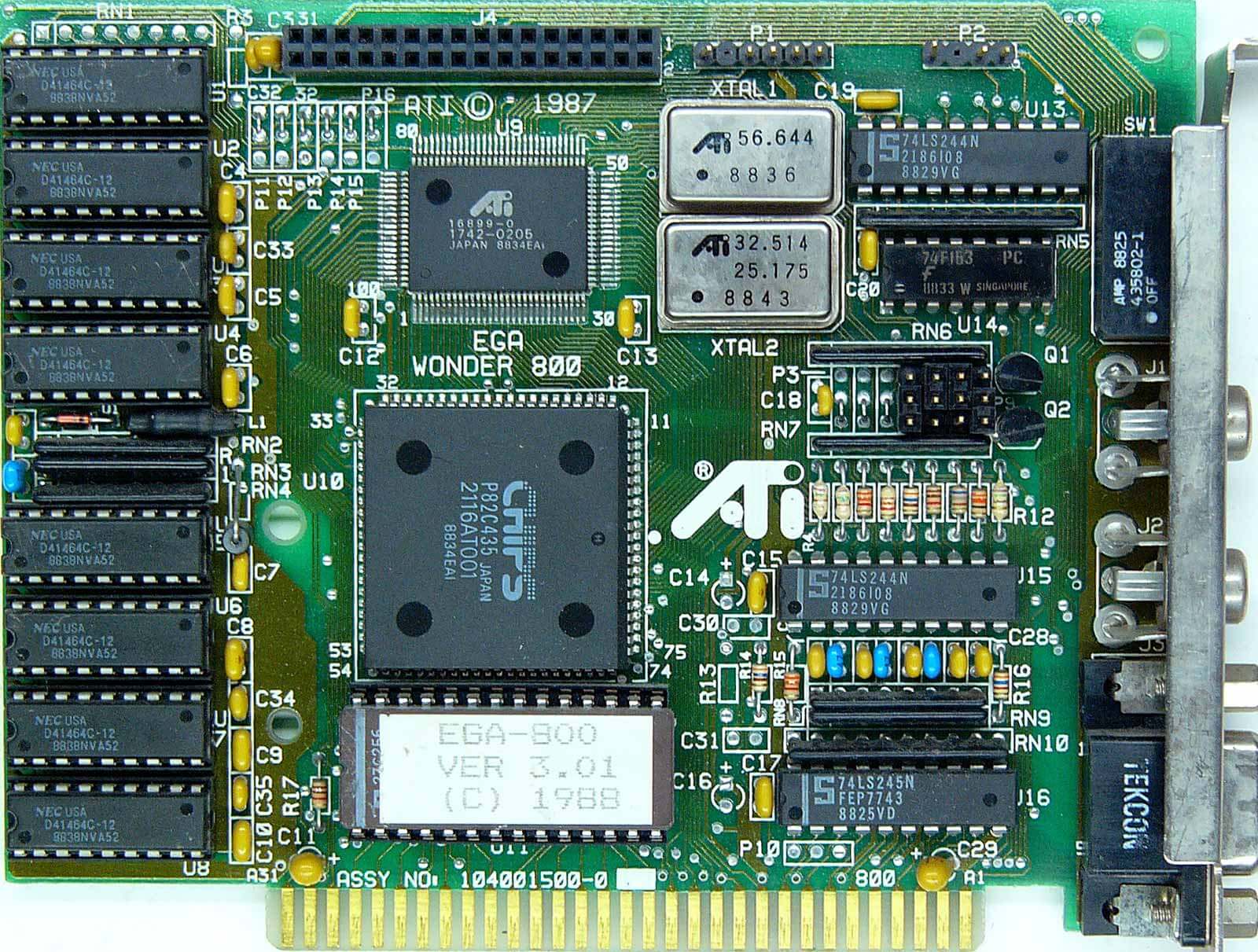
The EGA Wonder serial 1 to 4 arrived in March for $399, featuring 256KB of Drachma as well as compatibility with CGA, EGA and MDA emulation with adequate 640x350 and 16 colors. Extended EGA was available for the series 2,3 and 4.
Filling down the treble final stage was the EGA Admiration 800 with 16-color VGA emulation and 800x600 resolution backup, and the VGA Reinforced Performance (VIP) card, which was in essence an EGA Wonder with a digital-to-analog (DAC) added to provide limited VGA compatibility. The latter monetary value $449 plus $99 for the Compaq expansion module.
ATI was far from being unique horseback riding the fla of consumer appetite for personal computing.
Umpteen new companies and products arrived that yr.. Among them were Trident, Sister, Tamerack, Realtek, Oak Technology, LSI's G-2 Inc., Hualon, Cornerstone Imagination and Winbond -- altogether formed in 1986-87. Meanwhile, companies such as AMD, Western Digital/Nirvana Systems, Intergraph, Cirrus Logical system, TX Instruments, Gemini and Genoa, would produce their first graphics products during this timeframe.
ATI's Wonder serial continued to gain significant updates over the next a few eld.
In 1988, the Petite Wonder Graphics Resolution with game controller port and complex stunned options became available (for CGA and MDA emulation), likewise as the EGA Wonder 480 and 800+ with Extended EGA and 16-bit VGA keep, and also the VGA Wonder and Wonder 16 with added VGA and SVGA support.
A Question 16 was equipped with 256KB of retentivity retailed for $499, while a 512KB variant cost $699.
An updated VGA Wonder/Curiosity 16 series arrived in 1989, including the ablated cost VGA Edge 16 (Curiosity 1024 series). New features included a charabanc-Mouse port and support for the VESA Feature Connector. This was a gold-fingered connector similar to a shortened data bus expansion slot connector, and it linked via a ribbon cable to another video restrainer to go around a congested information bus.
The Wonder serial updates continued to move quickly in 1991. The Wonder XL card added VESA 32K color compatibility and a Sierra RAMDAC, which boosted maximum display solving to 640x480 @ 72Hz or 800x600 @ 60Hz. Prices ranged through $249 (256KB), $349 (512KB), and $399 for the 1MB Read/write memor option. A reduced cost version called the VGA Charger, based on the previous class's Basic-16, was also made available.
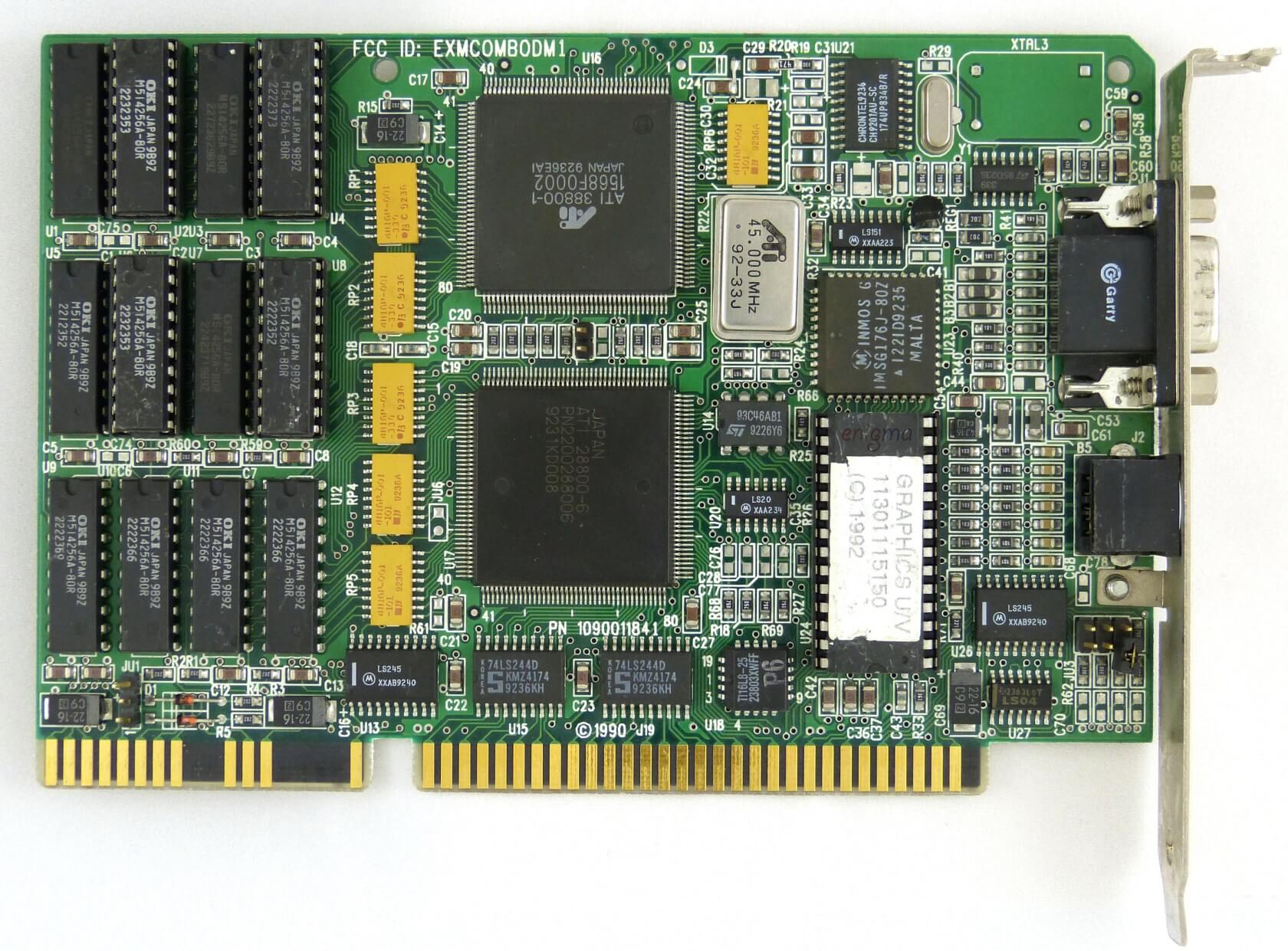
The Mach series launched with the Mach8 in May of that year. It sold Eastern Samoa either a chip or board that allowed, via a programming user interface (AI), the offloading of limited 2D drawing operations such as line-draw, color-fill and electronic image compounding (Bit BLIT).ATI added a magnetic declination of the Wonder XL that incorporated a Creative Sound Blaster 1.5 chip on an extended PCB. Titled the VGA Stereo-F/X, it was capable of simulating stereo from Sound Blaster mono files at something approximating FM radio quality.
Graphics boards such as the ATI VGAWonder GT, offered a 2D + 3D option, combining the Mach8 with the graphics core (28800-2) of the VGA Wonder+ for its 3D duties. The Question and Mach8 pushed ATI through the CAD$100 trillion sales milepost for the year, mostly happening the stake of Windows 3.0's espousal and the hyperbolic 2D workloads that could be employed with it.
S3 Graphics was conceived in ahead of time 1989 and produced its first 2D accelerator chip and a graphics card 18 months later, the S3 911 (or 86C911). Key specs for the latter included 1MB of VRAM and 16-bit color hold.
The S3 911 was superseded by the 924 that assonant year -- it was basically a amended 911 with 24-bit color -- and again updated the following year with the 928 which added 32-bit color, and the 801 and 805 accelerators. The 801 used an ISA user interface, while the 805 used VLB. Between the 911's introduction and the advent of the 3D gu, the commercialise was inundated with 2D GUI designs founded on S3's original -- notably from Tseng labs, Cirrus Logic, Trident, IIT, ATI's Mach32 and Matrox's Deceptio RGB.
In January 1992, Atomic number 14 Nontextual matter Inc (SGI) released OpenGL 1.0, a multi-platform vendor agnostic application programming interface (API) for both 2D and 3D graphics.
Microsoft was developing a rival API of their own called Direct3D and didn't precisely break a sweat making predictable OpenGL ran as swell as it could below Windows.
OpenGL evolved from SGI's proprietary API, called the IRIS GL (Integrated Raster Imaging Organization Written Program library). Information technology was an enterprisingness to keep non-written functionality from Fleur-de-lis, and earmark the API to keep going non-SGI systems, as rival vendors were opening to loom on the horizon with their own branded Genus Apis.
Initially, OpenGL was aimed at the white-collar UNIX system settled markets, but with developer-friendly support for extension effectuation information technology was rapidly adopted for 3D gaming.
Microsoft was developing a rival API of their possess titled Direct3D and didn't exactly break a sweat making sure OpenGL ran as well every bit it could under the new Windows operating systems.
Things came to a head a few years afterward when Trick Carmack of I.D. Software program, whose previously released Doom had revolutionised PC gaming, ported Quake to use OpenGL happening Windows and openly criticised Direct3D.
Microsoft's intransigence increased as they denied licensing of OpenGL's Mini-Client Driver (MCD) on Windows 95, which would allow vendors to opt which features would have access to hardware quickening. SGI replied by underdeveloped the Installable Client Driver (ICD), which not solitary provided the Sami ability, but did and then even ameliorate since MCD covered rasterization only and ICD added lighting and transform functionality (T&L).
During the rise of OpenGL, which initially gained traction in the workstation arena, Microsoft was busy eyeing the emergent gaming commercialize with designs on their own proprietary API. They acquired RenderMorphics in Feb 1995, whose Realism Lab API was gaining traction with developers and became the core for Direct3D.
At about the same time, 3dfx's Brian Hook was writing the Gliding API that was to become the dominant API for gaming. This was in part due to Microsoft's involvement with the Talisman visualise (a tile settled rendering ecosystem), which diluted the resources intended for DirectX.
As D3D became wide available on the back of Windows adoption, proprietary APIs such As S3d (S3), Matrox Apiculate Interface, Creative Graphics Library, C Interface (ATI), SGL (PowerVR), NVLIB (Nvidia), RRedline (Rendition) and Glide, began to lose favor with developers.
It didn't help matters that some of these proprietary APIs were allied with board manufacturers under multiplicative pressure to bring to a chop-chop expanding feature name. This included higher block out resolutions, increased coloration depth (from 16-bit to 24 then 32), and picture quality enhancements such as opposing-aliasing. All of these features called for increased bandwidth, graphics efficiency and faster product cycles.
By 1993, marketplace volatility had already unscheduled a number of graphics companies to withdraw from the business, or to be absorbed past competitors.
The twelvemonth 1993 ushered in a flurry of new graphics competitors, virtually notably Nvidia, supported in January of that class by Jen-Hsun Huang, Curtis Priem and Chris Malachowsky. Huang was previously the Director of Coreware at LSI while Priem and Malachowsky both came from Sun Microsystems where they had previously matured the SunSPARC-based GX artwork computer architecture.
Fellow newcomers Dynamic Pictures, Ark Logic, and Rendition joined Nvidia shortly thereafter.
Food market volatility had already forced a number of art companies to withdraw from the business, or to be absorbed by competitors. Amongst them were Tamerack, Gemini Technology, Genoa Systems, Hualon, Head Technology (bought by SPEA), Acer, Motorola and Acumos (bought by Cirrhus Logic).
One company that was moving from speciality to strength however was ATI.
As a precursor of the All-In-Inquire series, after-hours Nov saw the promulgation of ATI's 68890 PC TV decoder crisp which debuted inside the Video-It! card. The chip was able to catch video at 320x240 @ 15 Federal Protective Service, surgery 160x120 @ 30 Federal Protective Service, as well as pack together/decompress in real clock time thanks to the onboard Intel i750PD VCP (Video Compression Mainframe). It was also able to pass on with the graphics board via the information bus, thus negating the need for dongles or ports and ribbon cables.
The Video-IT! retailed for $399, while a lesser conspicuous model named Video-Basic completed the argumentation-up.
Five months future, in March, ATI belatedly introduced a 64-bit accelerator; the Mach64.
The financial year had not been kind to ATI with a CAD$2.7 million loss atomic number 3 it slipped in the marketplace amid strong competition. Competitor boards included the S3 Imagination 968, which was picked up by umteen board vendors, and the Trio64 which picked up OEM contracts from Dell (Dimension XPS), Compaq (Presario 7170/7180), AT&T (Globalyst),HP (Vectra VE 4), and DEC (Venturis/Celebris).
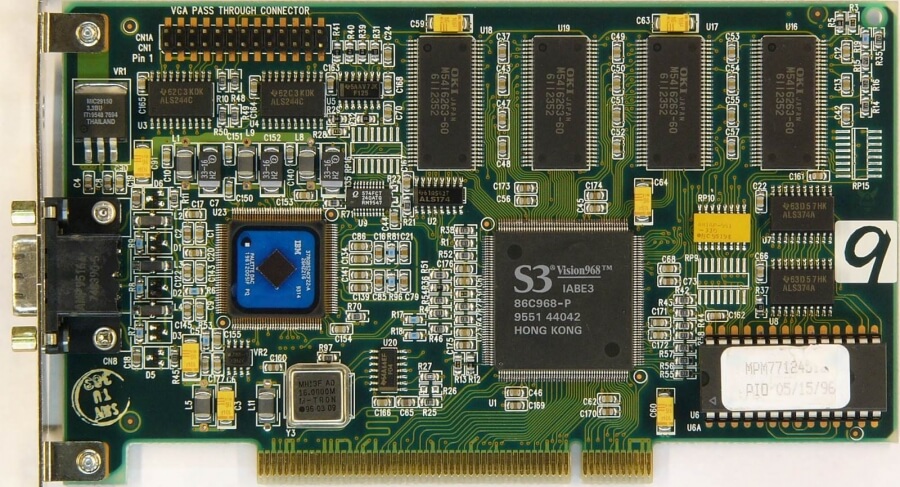
Released in 1995, the Mach64 notched a number of notable firsts. It became the first graphics adapter to be uncommitted for PC and Macintosh computers in the descriptor of the Xclaim ($450 and $650 depending on aboard memory), and, along with S3's Trio, offered full-motion video playback speedup.
The Mach64 also ushered in ATI's first pro graphics cards, the 3D Professional Turbo and 3D In favour of Turbo+PC2TV, priced at a cool $599 for the 2MB selection and $899 for the 4MB.
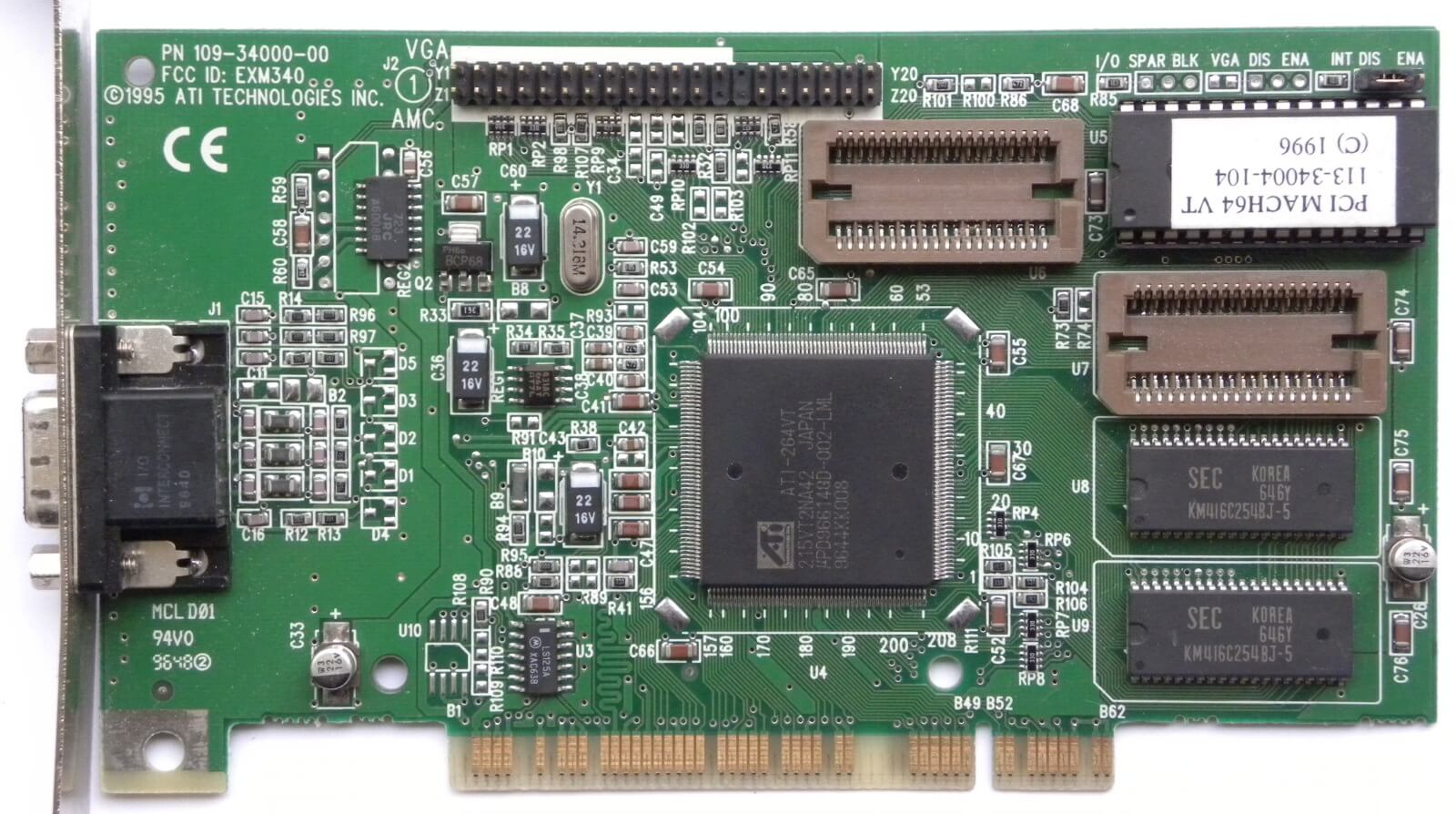
The following month saw a technology start-up named 3DLabs rise onto the scene, born when DuPont's Pixel graphics part bought the subsidiary from its parent company, along with the Glance 300SX processor capable of OpenGL rendering, fragment processing and rasterization. Due to their high price the company's cards were initially aimed at the professional food market. The Fujitsu Sapphire2SX 4MB retailed for $1600-$2000, while an 8MB ELSA GLoria 8 was $2600-$2850. The 300SX, however, was intended for the gaming commercialize.
S3 seemed to be everywhere at that time. The high-stop OEM marked was dominated by the company's Trio64 chipsets that integrated DAC, a nontextual matter controller, and clock synthesiser into a single poker chip.
The Gaming GLINT 300SX of 1995 featured a much-attenuate 2MB of memory. It used 1MB for textures and Z-buffer and the other for frame cushion, but came with an option to increase the VRAM for Direct3D compatibility for another $50 over the $349 inferior price. The posting failed to make headway in an already crowded marketplace, but 3DLabs was already working along a successor in the Permedia series.
S3 seemed to be everywhere at that time. The high-end OEM asterisked was dominated aside the company's Trio64 chipsets that integrated DAC, a graphics comptroller, and time synthesist into a single chip. They also utilised a co-ordinated frame buffer and supported hardware video recording sheathing (a dedicated portion of graphics memory for rendering video A the application requires). The Trio64 and its 32-bit memory bus sibling, the Trio32, were available as OEM units and standalone cards from vendors such A Diamond, ELSA, Sparkle, STB, Orchid, Hercules and Number Nine. Diamond Multimedia's prices ranged from $169 for a ViRGE based card, to $569 for a Trio64+ founded Diamond Stealth64 Video with 4MB of VRAM.
The mainstream end of the marketplace also included offerings from Trident, a age OEM supplier of no-frills 2D graphics adapters who had recently added the 9680 cow dung to its parentage-up. The chip boasted almost of the features of the Trio64 and the boards were generally priced around the $170-200 mark. They offered acceptable 3D performance in this bracket, with good video playback capableness.
Other newcomers in the mainstream market included Weitek's Superpowe Player 9130, and Alliance Semiconducting material's Publicity 6410 (usually seen as the Alaris Matinee operating theater FIS's OptiViewPro). Both offered fantabulous scaling with CPU speed, spell the latter combined the alcoholic scaling engine with antiblocking circuitry to obtain smooth video playback, which was much healthier than in past chips so much as the ATI Mach64, Matrox MGA 2064W and S3 Vision968.
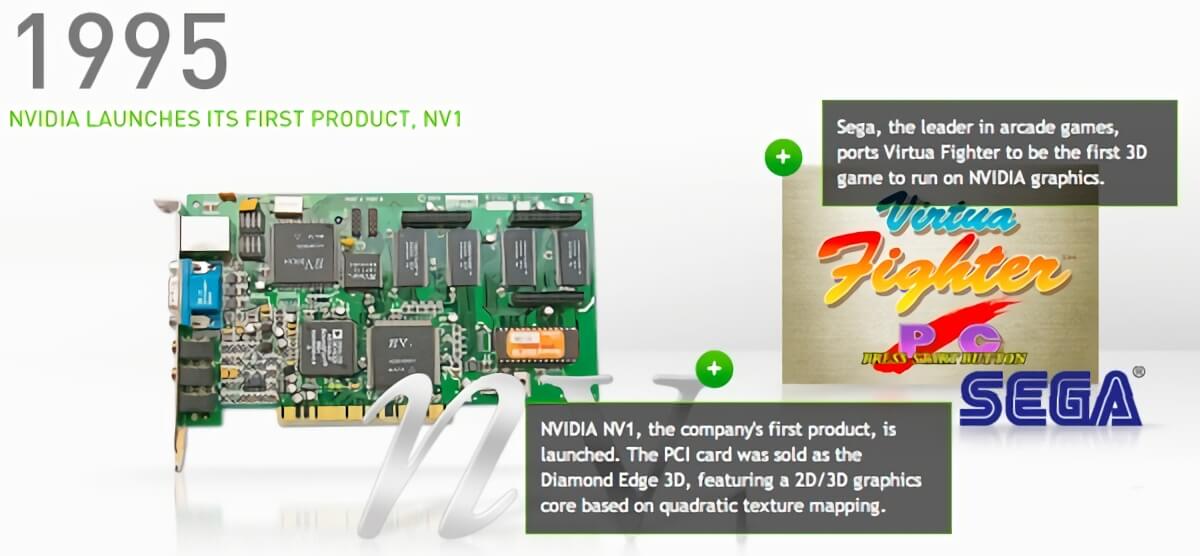
Nvidia launched their first graphics microchip, the NV1, in May, and became the first commercial graphics processor capable of 3D rendering, video acceleration, and integrated GUI acceleration.
They partnered with ST Microelectronic to produce the chip on their 500nm summons and the latter besides promoted the STG2000 translation of the cut off. Although it was not a huge success, it did play the first financial return for the company. Unfortunately for Nvidia, just arsenic the first trafficker boards started shipping (notably the Diamond Edge 3D) in September, Microsoft finalized and discharged DirectX 1.0.
The D3D graphics API confirmed that information technology relied upon rendering triangular polygons, where the NV1 used quad texture mapping. Limited D3D compatibility was added via driver to wrap triangles as quadratic polynomial surfaces, but a lack of games tailored for the NV1doomed the card as a jack of all trades, master of none.
Well-nig of the games were ported from the Sega Saturn. A 4MB NV1 with integrated Saturn ports (two per expansion square bracket conterminous to the notice via ribbon cable), retailed for around $450 in September 1995.
Microsoft's late changes and establish of the DirectX SDK left panel manufacturers incapable to directly access hardware for digital video playback. This meant that virtually all discrete nontextual matter cards had functionality issues in Windows 95. Drivers under Win 3.1 from a diverseness of companies were more often than not impeccable by contrast.
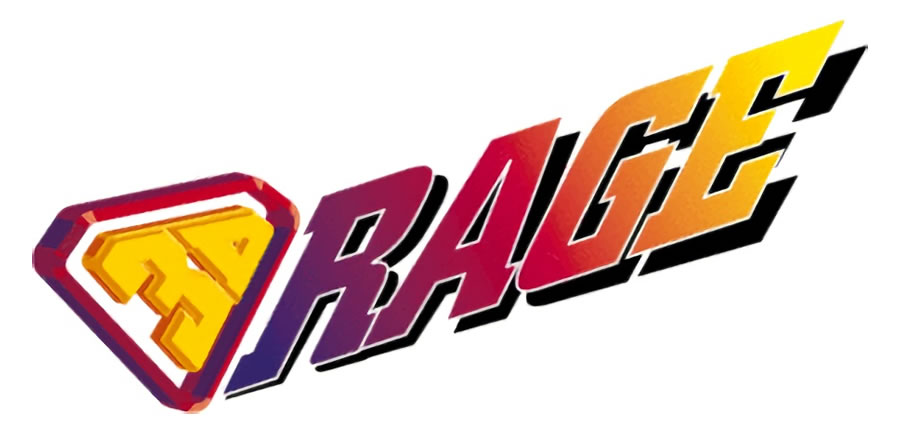
The first public demonstration of information technology came at the E3 computer game conference held in Los Angeles in May the following year. The card itself became available a month later. The 3D Rage unified the 2D core of the Mach64 with 3D capability.ATI announced their first 3D throttle flake, the 3D Rage (also known as the Mach 64 GT), in November 1995.
Late revisions to the DirectX specification meant that the 3D Rage had compatibility problems with many games that used the API -- chiefly the lack of depth buffering. With an on-add-in 2MB EDO Crash framing buffer, 3D sense modality was constricted to 640x480x16-bit or 400x300x32-bit. Attempting 32-bit colourize at 600x480 generally resulted in onscreen colorize corruption, and 2D firmness of purpose peaked at 1280x1024. If gaming performance was mediocre, the full screen door MPEG playback power at least went around manner in balancing the feature position.
The public presentation race was all over before it had started, with the 3Dfx Voodoo Graphics effectively destructive all rival.
ATI reworked the chip, and in September the Rage II launched. It corrected the D3DX issues of the first cow chip in addition to adding MPEG2 playback support. Initial card game, however, still shipped with 2MB of memory, hampering performance and having issues with linear perspective/geometry transform, As the series was expanded to include the Rage II+DVD and 3D Xpression+, memory capacity options grew to 8MB.
While ATI was first to market with a 3D graphics solution, it didn't take besides long for other competitors with differing ideas of 3D execution to arrive along the scenery. Namely, 3dfx, Rendition, and VideoLogic.
In the race to release new products into the marketplace, 3Dfx Interactive won over Rendition and VideoLogic. The performance race, however, was over before it had started, with the 3Dfx Vodoun Nontextual matter effectively annihilating all competition.
This is the prototypal article connected our History of the GPU series. If you enjoyed this, keep reading Eastern Samoa we takings a stroll down memory lane to the heyday of 3Dfx, Rendition, Matrox and Cy Young keep company known as Nvidia.
Source: https://www.techspot.com/article/650-history-of-the-gpu/
Posted by: hickmanittly1948.blogspot.com

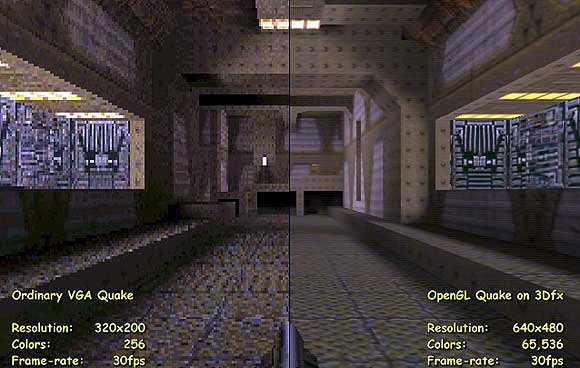

0 Response to "The History of the Modern Graphics Processor - hickmanittly1948"
Post a Comment